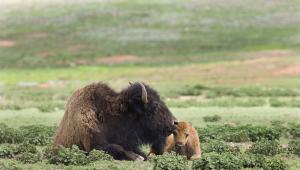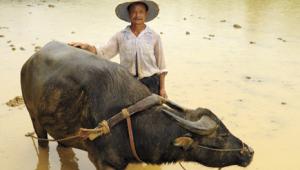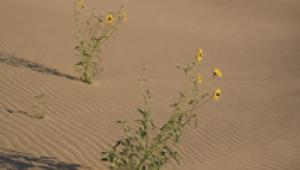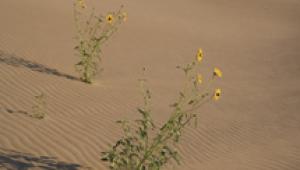Great Outdoors
(Upside) Down Under
I had already spent quite a bit of time photographing the fruit bats of Australia for a magazine assignment when I was approached to contribute to Daybreak 2000, a coffee-table book in which 120 photographers from all over the globe would document the state of the natural world on January 1, 2000. Since I knew I would be in Australia that day, the fruit bats, which are commonly called "flying foxes," became my Daybreak 2000 project. Flying foxes, which some scientists consider closely related to primates because of their appearance and behavior, used to live on nectar and petals of eucalyptus blossoms and flowers of other native plants as well as on wild forest fruit. Their main problem today, however, and one of the reasons why I have been documenting them, is the loss of much of their forest habitat due to clear-cutting. For this reason many colonies have been newly established close to cities, where the bats tend to feed in fruit orchards if not enough eucalyptus flowers and other traditional food sources are available to them. One of the colonies, or "camps," that I photographed is located near Brisbane and was established about 20 years ago. Currently several hundred thousand flying foxes are living in this camp. At first glance, flying foxes seem to be subjects that are relatively easy to photograph, and in one way they are. Apart from their nightly feeding forays, they share one main occupation during the day: they hang in trees, as you can see in my pictures. So just taking images of the bats is not too difficult; getting good photographs, however, is a different matter altogether. In order to achieve this goal, I first had to build a "hide" in their camp to get to eye level with them. With the permission of the land owner on whose property part of the colony was located, I constructed a platform supported by a 16 foot scaffold that leaned against one of the roosting trees. To avoid disturbing the bats, I set the scaffold in place over two consecutive nights while the flying foxes were away on their fly-outs. Over the platform I rigged a green tarp that hung down in front, concealing me from them, with holes cut in it for my lens and flash. Then, for about four weeks, I would get into position in the pitch dark of predawn and await their return. |
|||
My daily routine during this time consisted of shooting from around four in the morning until about 10 o'clock, when the light became too harsh. Then I climbed down from the hide for a few hours' rest. In early afternoon I returned to the hide to observe and photograph until dusk. Initially a few of the flying foxes were disturbed by my movements up and down the ladder, but they quickly settled back into their trees, realizing that I meant no harm. Even with the tarp in place, they were aware of my presence, but as time went by they became increasingly used to me. In fact, the tarp was quite useless for concealment--but not for protection. Remember that hundreds of the flying foxes hung above me in the tree and...well, you get the idea. The tarp protected me very well, but the front end of my lens was a different story; it needed constant cleaning. Flying foxes are very territorial. In the mornings when they returned, they often fought briefly over roosting sites. When another flying fox landed too close, there would be a quick skirmish and usually the intruder went away. Sometimes "away" meant just a foot or so on the branch. When I refer to "roosting site" I mean not only the tree, and not only a specific branch, but a specific part of a specific branch. Generally, though, the flying foxes are very friendly toward each other, and there is little aggression. When they roost, they do not keep their eyes closed for hours at a time. They wake up, look around, see what is going on--especially when a bird of prey circles above--and then go back to sleep when the danger is gone. Due to the long hours I spent in the hide, I was able to photograph them during those moments of alertness. |
|||
The amount of equipment I required forced me to make two trips up the ladder each time to bring my 60 lb backpack, camera case, and tripod to the platform. Most of the pictures, however, were taken with just one lens--a 600mm f/4 Nikkor AF-S. The flying foxes were as close as 20', sometimes less, but for format-filling portraits I still needed the 600, often with a 1.4 tele-converter. I used both an F5 and F100, and my film was Provia 100 F, which is the best film I've ever used for wildlife photography because of its extremely fine grain even when pushed one stop. My tripod is a Gitzo Mountaineer with an Arca Swiss ball head. One of the reasons photographing flying foxes is a challenge lies in the difficulty with lighting. Since flying foxes are very dark and the sur-rounding area usually several stops brighter, it's a real problem to get good exposures. Although I generally prefer only natural light in my photography, the key piece of my equipment during the flying fox shoot was an SB-26 Speedlight, which I often used for fill flash. If my subjects were too far away for the flash, even at full output, I used a Kirk Flash X-Tender, basically a Fresnel-lens magnifier that increases the flash unit's range. The general light conditions determined my flash output setting. On an overcast day, with soft ambient light, TTL flash metering with a compensation of minus 11/3 stops produced the best results. When I photo-graphed the flying foxes against a bright background, I had to use plus compensation. In any case, I made sure to bracket the flash unit's light output, as it's pretty much impossible to predict the perfect balance between ambient light and fill flash. Experience is good, but control is better! Never trust your experience alone, and always control the situation by eliminating errors. In this case, control was achieved with bracketing. Theo Allofs is a widely published wildlife and nature photographer. He has three coffee-table books to his credit in addition to numerous images featured in "International Wildlife," "American Photo," "Outside," and "BBC Wildlife Magazine," among other publications. His international awards include two top prizes in the prestigious BG Wildlife Photographer of the Year Competition. "Daybreak 2000," published by Northword Press, is available now. Readers can see more of Allofs' work on his web site at: www.naturbilder.de/allofsenglish. Beginning with this issue, Great Outdoors will appear on a bimonthly schedule in the magazine. |




















































